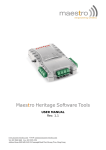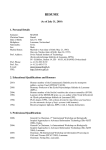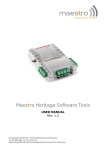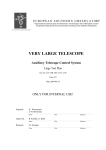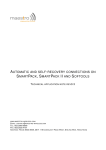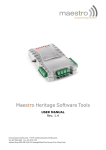Download Farallon Communications NetopiaTM Network Card User Manual
Transcript
GSM GPRS Modem
900 / 1800
Value Added Feature
USER MANUAL
Confidential, the whole present document is the sole property of Fargo Telecom (Asia) Ltd.
Revision history
Rev. Date
0.9
22July 2005
0.91 22Feb 2006
0.92
Details
First release
- Remove AT command history feature
- Remote AT command : when enabled all
incoming SMS will be erased
AutoTCP/UDP : Add DCD/DSR signaling
: modify command/data mode
swithcing
Originated by
Wallace Lee
Wallace Lee
Wallace Lee
Fargo Maestro is a registered trademark of Fargo Telecom AsiaLtd.
This manual is written without any warranty. Fargo Telecom AsiaLtd reserves the right to
modify or improve the product and its accessories which can also be withdrawn without prior
notice.
Besides, our company stresses the fact that the performance of the product as well as
accessories depends not only on the proper conditions of use, but also on the environment
around the places of use.
Fargo Telecom AsiaLtd assumes no liability for damage incurred directly or indirectly from
errors, omissions or discrepancies between the modem and the manual.
Confidential, the whole present document is the sole property of Fargo Telecom (Asia) Ltd.
ERAL
Table of contents
1.
INTRODUCTION..................................................................................................................................................................... 2
2.
INSTALLATION....................................................................................................................................................................... 2
2.1 IDENTIFYING YOUR FARGO MAESTRO ..................................................................................................................................... 2
2.1.1
Identifying Fargo Maestro 20 ...................................................................................................................................... 2
2.1.2
Identifying Fargo Maestro 100 .................................................................................................................................... 2
2.2 INSTALLING THE VALUE ADDED FEATURE ............................................................................................................................... 3
2.2.1
Erasing the IP connectivity feature (AT# feature) (Fargo Maestro 100 only)............................................................... 3
2.2.2
Downloading the file .................................................................................................................................................... 3
3.
AUTO TCP/UDP CONNECTION (FARGO MAESTRO 100 ONLY)................................................................................. 5
3.1 FLOW DIAGRAM OF AUTO TCP/UDP FUNCTION ..................................................................................................................... 5
3.2 AT COMMANDS FOR AUTO TCP/UDP ..................................................................................................................................... 6
3.2.1
AT+AUTOTCP............................................................................................................................................................. 6
3.2.2
AT+IPTCP .................................................................................................................................................................... 7
3.2.3
AT+AUTOTCP............................................................................................................................................................ 8
3.2.4
AT+IPUDP................................................................................................................................................................... 9
3.2.5
AT+IPGPRS............................................................................................................................................................... 11
3.2.6
AT+IPBUFF............................................................................................................................................................... 12
4.
REMOTE AT COMMAND BY SMS .................................................................................................................................... 14
4.1 DESCRIPTION OF THE OPERATION .......................................................................................................................................... 14
4.2 AT COMMAND FOR CONFIGURING AT COMMAND BY SMS.................................................................................................... 15
4.2.1
AT+SMSAT ............................................................................................................................................................... 15
4.3 LIMITATION AND CAUTION TO BE TAKEN WHEN USING REMOTE AT COMMAND ..................................................................... 15
5.
I/O TRIGGERED AT COMMAND ..................................................................................................................................... 17
5.1 DESCRIPTION OF THE OPERATION.......................................................................................................................................... 17
5.2 AT COMMAND FOR CONFIGURING AT COMMAND BY SMS.................................................................................................... 18
5.2.1
AT+IOAT .................................................................................................................................................................... 18
5.3 NOTES AND CAUTIONS TO BE TAKEN WHEN USING I/O TRIGGERED AT COMMAND ................................................................ 19
6.
KNOWN ISSUES .................................................................................................................................................................... 20
6.1
6.2
7.
AT+WIND COMMAND .......................................................................................................................................................... 20
SAVING OF PARAMETERS TO NON-VOLATILE MEMORY ........................................................................................................... 20
QUESTIONS AND ANSWERS ............................................................................................................................................. 21
7.1
7.2
7.3
7.4
INSTALLATION ....................................................................................................................................................................... 21
AUTOTCP/UDP .................................................................................................................................................................... 21
AT COMMAND BY SMS ......................................................................................................................................................... 21
I/O TRIGGERED AT COMMAND .............................................................................................................................................. 21
Confidential, the whole present document is the sole property of Fargo Telecom (Asia) Ltd.
1
1. INTRODUCTION
The Fargo Maestro Value-Added Feature package is a software solution for Fargo Maestro modem
(*see note 1). New functions added are to increase application range of various industrial and
automated applications:
-
Automatic and self-recovery TCP/UDP socket connection (* see note 2)
Remote AT command (AT command through SMS)
I/O triggered AT command execution
Users can configure and use the above features by AT commands.
Note 1: Not all Fargo Maestro can have this feature installed. Please refer to Chapter 2
Note 2: For Fargo Maestro 100 with TCP/IP only
2. INSTALLATION
2.1 Identifying your Fargo Maestro
Not all Fargo Maestro can have the Value-added feature installed, so you need to check if your
Fargo Maestro before installation first.
2.1.1
Identifying
argo
F Maestro 20
Start HyperTerminal, choose correct baud rate to communicate with the modem (default is
9600bps, 8N1)
Then enter the following and see the response according to the following table :
Command
AT+WOPEN=2
Expected response
+WOPEN: 2,"AT v02.10"
If you get the same response then this modem is ready for installation.
2.1.2
Identifying Fargo Maestro 100
Start HyperTerminal, choose correct baud rate to communicate with the modem (default is
115200bps, 8N1)
Confidential, the whole present document is the sole property of Fargo Telecom (Asia) Ltd.
2
Then enter the following and see the responses according to the following table:
Command
AT#VVERSION
AT+WOPEN=2
Expected response
#VERSION: "eDsoft-W302_V2.10 116686 Dec 10
2003 12:20:17"
+WOPEN: 2,"AT v02.10", “AT V02.10”
If you get the same response then this modem is ready for installation.
2.2 Installing the Value added feature
2.2.1
Erasing the
IP connectivity feature (AT# feature) (Fargo Maestro 100 only)
For Fargo Maestro 100, you need to erase the IP connectivity feature before downloading the
Value added feature. Again, on HyperTerminal enter the following commands step by steps :
Command
AT+WOPEN=0
AT+WOPEN=3
AT+WOPEN=4
2.2.2
Expected response
(modem will reset)
OK
(modem will reset)
Downloading the file
a. Check the HyperTerminal is configured with setting “8 data bits, no parity, 1 stop bit, and
hardware flow control (CTS/RTS)
b. For Fargo Maestro 20, it is suggested to set the baud he RS232 link is changed to 115200
bps. You can first start HyperTerminal session with 9600 bps. The on the screen type
command AT+IPR = 115200 and then press “Enter”. Then change the HyperTerminal speed
to 115200bps. (For Fargo Maestro 100 the default speed is 115200bps)
c. On the screen type the command AT+WDWL and then press “Enter”. The modem should
answer +DWL: 0, and then a series of strange characters appears or the cursor is just
moving forward slowly. (the module is sending the first characters of the Xmodem protocol).
d. Then on HyperTerminal you choose “Transfer” –“Send File”
Confidential, the whole present document is the sole property of Fargo Telecom (Asia) Ltd.
3
e. When you see the dialog box, on the “Filename” you choose file according to the modem:
Fargo Maestro 20 : F100VAF_0092.dwl
Fargo Maestro 100 : F20VAF_0092.dwl
Then on “Protocol” choose “1K-Xmodem”, Then press “OK”
f.
Then the downloading process will start:
g. After finishing downloading enter command AT+CFUN=1 to restart modem
h. After restarting enter command AT+WOPEN=1 to start the VAF program.
i. Enter one VAF AT command to verify :
Command
AT+SMSAT?
Expected response
+SMSAT : 0,000000
OK
Now the Fargo Maestro Value added Feature installation has been done. You can follow other
chapters to use the features.
Not all Fargo Maestro can have the Value-added feature installed, so you need to check if your
Fargo Maestro before installation first.
Confidential, the whole present document is the sole property of Fargo Telecom (Asia) Ltd.
4
3. AUTO TCP/UDP CONNECTION (Fargo Maestro 100 only)
The Auto TCP/UDP connection feature is defined for accessing serial devices over the Internet.
Fargo Maestro can be configured that after power up it will connect to a remote TCP/UDP socket
(client mode) or to wait for the TCP/UDP socket connection request from remote peer (server
mode).
If the socket connection is unsuccessful or disconnected it will repeat the connection request and
back to waiting stage. This make remote peer can access serial device connected to Fargo
Maestro.
3.1 Flow diagram of Auto TCP/UDP function
M odem Power on/
restart
No
Is AutoTCP/UDP
enabled ?
Stop
Yes
W ait for 20 secs
No
Re-attach GPRS
No
GPRS attach OK ?
Yes
Re-activate G PRS
No
GPRS activation OK ?
Yes
TCP/UDP connection
request from allowed
peer?
No
No
Client m ode ?
Yes
No
OK to open pre-defined
TCP/UDP socket ?
Dealy 2
seconds
Yes
No
Open TCP/UDP
socket, connect to
serial port
Open TCP/UDP
socket, connect to
serial port
TCP/UDP
disconnected or
closed ?
TCP/UDP
disconnected or
closed ?
Yes
Yes
GPRS attach fail ?
No
Yes
GPRS activation
fail ?
No
No
Yes
GPRS attach fail ?
Yes
No
GPRS activation
fail ?
Yes
No
Confidential, the whole present document is the sole property of Fargo Telecom (Asia) Ltd.
5
3.2 AT commands for Auto TCP/UDP
3.2.1
AT+AUTOTCP
Description:
This command controls the Maestro 100 to start TCP socket connection automatically.
Note:
- Before using AT+AUTOTCP TCP and GPRS settings MUST be setup properly using
AT+IPTCP and AT+IPGPRS command respectively.
- +AUTOTCP function is mutually exclusive with +AUTOUDP function; if +AUTOUDP is set to
1 already you will get ERROR on enabling AUTOTCP
Syntax:
Command Syntax
AT+AUTOTCP=<mode>
Response syntax:
+AUTOTCP: <mode>
Command
AT+AUTOTCP=0
AT+AUTOTCP=1
AT+ AUTOTCP?
AT+AUTOTCP=?
Possible responses:
OK
Note : disable AutoTCP
OK
Enable AutoTCP
+AUTOTCP : 1
OK
Note display current status
+AUTOTCP : (0-1)
Note : possible argument
Defined Values:
<mode>
1 enable auto TCP
0 disable auto TCP
Notes :
Before enabling Auto TCP, it MUST be properly set the GPRS settings by AT+IPGPRS
command and TCP settings by AT+IPTCP command
ONLY GPRS PDP context # 1 will be used. So please setup +IPGPRS settings with
<cid>=1
Once AutoTCP is enabled, it will start the TCP socket connection automatically after 20
seconds.
Once the TCP connection is established successfully, the serial port will go to data mode,
all data entered to the serial port will be sent to remote TCP peer. No more AT commands
will be accepted then.
In TCP connected data mode, the DSR and DCD signals of the serial port will go to high.
Confidential, the whole present document is the sole property of Fargo Telecom (Asia) Ltd.
6
-
If the TCP connection is broken the modem will try to reconnect automatically. During reconnection period serial port will go back to command mode, and DSR/DCD signal back
to low.
The setting will be saved, and after power off, the AUTOTCP will be restarted with the 20
seconds delay after power up.
To stop auto TCP connection, you need to enter the command AT+AUTOTCP=0 within
20 seconds after power up, or during reconnection (serial port back to command mode)
3.2.2
AT+IPTCP
Description:
This command specifies the TCP socket parameters and mode that to be used by
AT+AUTOTCP command.
Syntax:
Command Syntax
AT+IPTCP=<port>,<mode>,<server>,<TCPTxDelay>
Response syntax:
+ IPTCP: <port>,<mode>,<server>,<TCPTxDelay>
Command
Possible responses:
+IPTCP: 0,"S","",100
OK
Note : show current settings
AT+ IPTCP =23
OK
Note: set the TCP port to 23
AT+ IPTCP =23,”C”,202.144.111.222”,100 OK
Note: to set the modem to connect TCP socket Client
(caller) mode
to target :address 202.144.111.222 and port 23
AT+ IPTCP =23,”S”,255.255.255.255”,100 OK
to set the modem to wait for TCP socket connection
request (Server (listening) mode)
any calling IP address allowed, port 23
AT+ IPTCP =?
+IPTCP: (0-65535),("C","S"),(120),(0-32760)
OK
Note : possible argument
AT+ IPTCP?
Defined Values:
<port>
The port number to be used for the TCP socket connection. Default value is 0. Valid range is 0
to 65535.
Confidential, the whole present document is the sole property of Fargo Telecom (Asia) Ltd.
7
<mode>
Mode of TCP operation. Default value is “S”.
“S” Server (Listening) mode. This configures Fargo Maestro to open a listening TCP
connection on the specified port . The TCP connection will be active upon getting socket
connection request from the allowed remote TCP peer (see <address>)
“C” Client (caller) mode. This configures Fargo Maestro to request opening a TCP to the
server with the specified address and port .
<address>
The address of the TCP server (or host). Default value is empty. Legal values could be 32-bit
in dotted-decimal notation (i.e. xxx.xxx.xxx.xxx) or alphanumeric ASCII test string up to 120
characters (only if DNS is available on the GPRS network)
Note: In “Server” (Listening) mode the modem will only accept TCP connection request for the
caller with address specified in the <address> field. Yet if the address is set to
“255.255.255.255” the modem will accept request from ANY address.
<TCPTxDelay>
This parameter determines the time delay introduced before sending a TCP frame that has not
been entirely filled with user data. The timer is entered in milliseconds and it should be noted
that a value of ‘0’ initiates the sending of a TCP frame as soon as possible after the reception
of a single character value from the host.
The default value is 100.
3.2.3
AT+AUTOTCP
Description:
This command controls the Maestro 100 to start UDPcket connection automatically.
Note :
- Before using AT+AUTOUDP TCP and GPRS settings MUST be setup properly using
AT+IPUDP and AT+IPGPRS command respectively.
- +AUTOUDP function is mutually exclusive with +AUTOTCP function; if +AUTOTCP is set to 1
already you will get ERROR on enabling AUTOUDP
Syntax:
Command Syntax
AT+AUTOUDP=<mode>
Response syntax:
+AUTOUDP: <mode>
Confidential, the whole present document is the sole property of Fargo Telecom (Asia) Ltd.
8
Command
AT+AUTOUDP=0
AT+AUTOUDP=1
AT+ AUTOUDP?
AT+AUTOUDP=?
Possible responses:
OK
Note : disable AutoUDP
OK
Note: Enable AutoUDP
+AUTOUDP : 1
OK
Note: display current status
+AUTOUDP : (0-1)
Note : possible argument
Defined Values:
<mode>
1 enable auto UDP
0 disable auto UDP
Notes :
Before enabling Auto UDP, it MUST be properly set the GPRS settings by AT+IPGPRS
command and UDP settings by AT+IPUDP command
ONLY GPRS PDP context # 1 will be used. So please setup +IPGPRS settings with
<cid>=1
Once AutoUDP is enabled, it will start the UDP socket connection automatically after 20
seconds.
Once the UDP connection is established successfully, the serial port will go to data mode,
all data entered to the serial port will be sent to remote TCP peer. No more AT commands
will be accepted then.
In UDP connected data mode, the DSR and DCD signals of the serial port will go to high.
If the UDP connection is broken the modem will try to reconnect automatically. During reconnection period serial port will go back to command mode, and DSR/DCD signal back
to low.
The setting will be saved, and after power off, the AUTOUDP will be restarted with the 20
seconds delay after power up.
To stop auto UDP connection, you need to enter the command AT+AUTOUDP=0 within
20 seconds after power up, or during reconnection (serial port back to command mode)
3.2.4
AT+IPUDP
Description:
This command specifies the UDP socket parameters and mode that to be used by
AT+AUTOUDP command.
Syntax:
Command Syntax
AT+IPUDP=<port>,<mode>,<server>,<UDPTxDelay>
Response syntax:
+ IPUDP: <port>,<mode>,<server>,<UDPTxDelay>
Confidential, the whole present document is the sole property of Fargo Telecom (Asia) Ltd.
9
Command
Possible responses:
AT+ IPUDP?
+IPUDP: 0,"S","",100
OK
Note : show current settings
AT+ IPUDP =23
OK
Note: set the UDP port to 23
AT+ IPUDP =23,”C”,202.144.111.222”,100 OK
Note: to set the modem to connect UDP socket
Client (caller) mode to target :address
202.144.111.222 and port 23
AT+ IPUDP =23,”S”,255.255.255.255”,100 OK
Note: to set the modem to wait for UDP socket
connection request (Server (listening) mode)
any calling IP address allowed, port 23
AT+ IPUDP =?
+IPUDP: (0-65535),("C","S"),(120),(0-32760)
OK
Note : possible argument
Defined Values:
<port>
The port number to be used for the UDP socket connection. Default value is 0. Valid range is 0
to 65535.
<mode>
Mode of UDP operation. Default value is “S”.
“S” Server (Listening) mode. This configures Fargo Maestro to open a listening UDP
connection on the specified port . The UDP connection will be active upon getting socket
connection request from the allowed remote UDP peer (see <address>)
“C” Client (caller) mode. This configures Fargo Maestro to request opening a UDP to the
server with the specified address and port .
<address>
The address of the UDP server (or host). Default value is empty. Legal values could be 32-bit
in dotted-decimal notation (i.e. xxx.xxx.xxx.xxx) or alphanumeric ASCII test string up to 120
characters (only if DNS is available on the GPRS network)
Note: In “Server” (Listening) mode the modem will only accept UDP connection request for the
caller with address specified in the <address> field. Yet if the address is set to
“255.255.255.255” the modem will accept request from ANY address.
<UDPTxDelay>
This parameter determines the time delay introduced before sending a UDP frame that has not
been entirely filled with user data. The timer is entered in milliseconds and it should be noted
that a value of ‘0’ initiates the sending of a UDP frame as soon as possible after the reception
of a single character value from the host.
The default value is 100.
Confidential, the whole present document is the sole property of Fargo Telecom (Asia) Ltd.
10
3.2.5
AT+IPGPRS
Description:
This command is used to setup GPRS network parameters for the AutoTCPUDP feature.
Syntax:
Command Syntax
AT+IPGPRS=<Cid>,<APN>,<UN>,<PW>
Response Syntax
+IPGPRS: <Cid>,<APN>,<UN>,<PW>
Command
AT+ IPGPRS?
AT+ IPGPRS=1
AT+ IPGPRS =1,”INTERNET”
AT+ IPGPRS=?
Possible responses:
+IPGPRS: 1,"INTERNET","" ,””
OK
Note : show current settings
OK
Note: set Cid value to 1
OK
Note: set the PDP value to 1 and APN to “INTERNET”
+IPGPRS: (1-4),(100),(50),(50)
OK
Note: possible values
Defined Values :
<Cid>
PDP context identifier.
Note: to use with AT+AUTOTCP/ AT+AUTOUDP command this value must be set to 1.
<APN>
Access point name of the GPRS network. Max 100 characters.
<UN>
User name to access the GPRS service. Max 50 characters.
<PW>
Password used to access the GPRS service. Max 50 characters.
Confidential, the whole present document is the sole property of Fargo Telecom (Asia) Ltd.
11
3.2.6
AT+IPBUFF
Description:
This command specifies the number of bytes of data from remote peer buffered inside the
modem.
-
If the quantity of buffered data reach this value, the whole buffered data will be sent out to
the serial port.
-
If the data from remote is large at one time, only multiple of this value data will be sent out
to the serial port remainder will be kept inside buffer
Example: AT+IPBUFF=5
1234567890A
BCDEFGH
1234567890A
BCDE
FGH
18 bytes of data sent
from TCP or UDP
socket to modem
15 bytes (multiple of
5) data sent out to
serial port, remaining
data buffered inside
the modem
Syntax:
Command Syntax
AT+IPBUFF=<buff>
Response syntax:
+ IPBUFF: <buff>
Command
AT+ IPBUFF?
AT+ IPBUFF =10
AT+ IPBUFF =0
Possible responses:
+IPBUFF: 0
OK
Note : show current settings
OK
Note : set the IPBUFF value to 10
OK
Note: disable buffering when set the value to 0
Confidential, the whole present document is the sole property of Fargo Telecom (Asia) Ltd.
12
Defined Values :
<buff>
The number of bytes of data to be buffered. Default value is 0 (i.e. no buffering). Valid range is
0 to 50.
Notes:
- If the TCP or UDP socket connection is broken, buffered data will be lost.
Confidential, the whole present document is the sole property of Fargo Telecom (Asia) Ltd.
13
4. REMOTE AT COMMAND BY SMS
This feature is to control the modem to interpret AT command from incoming SMS, executing it,
and return the result to sender by SMS.
The user can enable the modem to receive AT command by incoming SMS. See following about
AT+SMSAT command.
4.1 Description of the Operation
Step 1 : send AT command
to modem by SMS
000000AT+CSQ
Step 2 : modem execute and
return response by SMS
+CSQ: 17,0 OK
1. When enabled, the modem will treat the incoming SMS as a source of AT command only if
all of the following conditions (a,b and c) are fulfilled :
a. The content of SMS sent to the modem is using standard 7-bit GSM data decoding scheme,
b. The first 6 characters of the SMS content matches the <key> parameter set by AT+SMSAT
command, (default key is “000000”)
c. The 7th and 8th characters of the SMS content is “AT” (in capital letters)
2. If SMSAT is enabled , the modem will read each incoming SMS, if the conditions mentioned in 1
are matched the message will be executed, even it is an invalid AT command
3. When using SMSAT feature, only +CNMI:x,1,x,x,x setting could be used (i.e. incoming message
will be stored in SIM card). If the incoming SMS is treated as with AT command inside, the SMS
will be deleted after execution. If not the modem will leave it in SIM, just like normal SMS.
4. The maximum length of the AT command is limited by length of SMS, i.e. 160-6 = 154 characters
5. When the SMS AT command is executed , all intermediate and final responses will be buffered
recorded, then return to the sender’s phone number in one single SMS.
6. If response(s) of the AT command is(are) more than 160 characters, only the first 160 characters
will be returned.
7. In case the modem cannot get terminal response within 26 seconds, the modem will then abort
the command, and return intermediate responses (if present).
8. If SMSAT feature is enabled all incoming SMS, either with valid AT command or not, will be
erased. This is to prevent SIM card memory from fully filled, such the modem will not receive
new SMS.
Confidential, the whole present document is the sole property of Fargo Telecom (Asia) Ltd.
14
4.2 AT command for configuring AT command by SMS
4.2.1
AT+SMSAT
Command Syntax
AT+SMSAT=<mode>(,<key>)
Response syntax:
+SMSAT: <mode>,<key>
Command
AT+SMSAT=0
AT+ SMSAT =1
AT+ SMSAT?
AT+SMSAT=2,123456
AT+ SMSAT =?
Possible responses:
OK
Note : disable remote AT command by SMS
OK
Enable remote AT command by SMS
+SMSAT : 1,000000
OK
Note display current status
OK
Note: set the <key> value
+SMSAT : (0-2),(6)
OK
Note : possible argument
Defined Values:
<mode>
0 disable remote AT command by SMS
1 enable remote AT command by SMS
<key>
A 6-digit numeric character key from 000000 to 999999. Only incoming SMS with the first 6
characters matching with this key will be treated as a valid source of remote AT command.
4.3 Limitation and caution to be taken when using remote AT command
This feature will not ‘judge’ the result of executing the command, so care has to be taken not to
enter improper command that make the modem becoming out of control:
1. Never send ‘interactive’ AT command by SMS, e.g. AT+CMGS=….
This feature cannot return the prompt to the sender for second input
2. Always wait for the return SMS with AT responses before you send another SMS AT command.
3. Currently commands created by OpneAT (e.g. AT+SMSAT) cannot be sent by SMS.
Confidential, the whole present document is the sole property of Fargo Telecom (Asia) Ltd.
15
4. It could be in some case (e.g. network failure) the modem cannot return response SMS. The
modem will try sending response SMS for three times max. If still not successful it will abort.
5. Always think twice before you send AT command by SMS. For example if you send AT+CPOF it
will turn off the modem, and you need to go to access the modem to reset it.
Confidential, the whole present document is the sole property of Fargo Telecom (Asia) Ltd.
16
5. I/O TRIGGERED AT COMMAND
This feature making use of the Fargo Maestro Input/Output port as a sensor. If the signal to the port
match the pre-defined condition a stored AT command will be executed.
User can use AT+IOAT command to set the condition and store AT command to be executed.
5.1 Description of the operation
I/O port
Wiring Diagram :
1. When the I/O port is connected to high 3V signal,
Switch closed : logic level high
Switch opened : logic level low.
2. The switch can be placed as a triggering device, e.g. to detect door opening.
3. According to the setting of AT+IOAT command, the stored AT command will be executed either
I/O signal from high to low, or from low to high :
When set as low-to-high triggering:
Start counting time when
a low to high signal
changed detected
when period of high signal
reach the Threshold value
the AT command will be
executed
I/O port volatge
time = T
Confidential, the whole present document is the sole property of Fargo Telecom (Asia) Ltd.
17
When set as high-to-low triggering :
I/O port voltage
time = T
Start counting time when
a high to low signal
changed detected
when period of low signal
reach Threshold value the
AT command will be
executed
* See AT+IOAT command on setting Threshold value T.
5.2 AT command for configuring I/O triggered AT command
5.2.1 AT+IOAT
Command Syntax
AT+IOAT=<action>(,<dir>,<Threshold>,<cmd> )
Response syntax:
+SMSAT: <action>,<dir>,<Threshold>,<cmd>
Command
AT+IOAT=0
AT+IOAT =1
AT+ IOAT?
AT+IOAT=2,1,10,”AT+IPR=115200”
AT+ IOAT =?
Possible responses:
OK
Note : disable I/O triggered AT command execution
OK
Enable remote I/O triggered AT command execution
+IOAT : 1,1, 10,”AT+CMSS=5”
OK
Note display current status
OK
Note: set the parameters < dir>, <Threshold>, <cmd>
low-to-high triggering, Threshold=1000 ms
command is “AT+IPR=115200”
+IOAT : (0-2),(0-1),(1-50),(128)
OK
Note : possible argument
Defined Values:
<action>
0 disable I/O triggered AT command execution
1 enable I/O triggered AT command execution
2 configure I/O triggered AT command parameters
<dir>
0 configure as low-to-high triggering
1 configure as high-to-low triggering
Confidential, the whole present document is the sole property of Fargo Telecom (Asia) Ltd.
18
<Threshold>
Time required for the detected state to trigger the AT command exestuation. Unit is in
millisecond.
Valid value from 1 to 50 (0.1 sec to 5 sec). Refer to the above timing diagram in section 5.1.
<cmd>
AT command to be executed when the I/O port is triggered successfully. The length of the
command is limited to 128 characters. See section 5.3 for more details.
5.3 Notes and cautions to be taken when using I/O triggered AT command
1. The I/O port is limited to drain current 10mA max. Never give too high input voltage to the I/O
port or the modem will be damaged.
2. Use only cable/metal contact designed for Molex MicroFit™ connector. Using incompatible
connector will damage the modem. Contact your dealer or FargoTelecom if you need wire for the
I/O port connection.
3. The modem will NOT check the command you entered to the <cmd> field. It will be executed
even it is not a valid AT command (or even not an AT command). Check by yourself when you
enter the command.
4. When triggered, the command will be executed in ‘quiet’ mode, i.e. without any response like
“OK” or “ERROR” will be sent to external application.
5. Do not enter “interactive” AT command (e.g. AT+CMGS=…), otherwise when the command is
executed, the modem will in a state of waiting further input, not to do other jobs.
6. With this feature enabled user cannot control the I/O port by other AT commands anymore.
7. Due to product limitation the modem cannot detect switching action with period less than 100ms.
If the switch’s open/close action is done in less than 100ms this feature will not be able to detect
accurately.
Confidential, the whole present document is the sole property of Fargo Telecom (Asia) Ltd.
19
6. KNOWN ISSUES
The Fargo Maestro Value Added Feature will affect certain other AT commands’ operation. Please
note :
6.1 AT+WIND command
1. AT+WIND command will be disabled (Fargo Maestro 100 only)
6.2 Saving of parameters to non-volatile memory
1. You cannot save the settings of the following AT commands by concatenating the &W
command (Fargo Maestro 100 only):
AT+CREG
AT+CGREG
AT+CGEREP
To save the above settings please enter AT&W separately.
Please read also Chapter 7 for other issues.
Confidential, the whole present document is the sole property of Fargo Telecom (Asia) Ltd.
20
7. QUESTIONS AND ANSWERS
7.1 Installation
Q. If my Fargo Maestro cannot match with the requirement stated in section 2.1, can I upgrade it?
A. No. Older Fargo Maestro cannot be upgraded.
Q. Can I have the TCP/IP (IP connectivity) feature together with this VAF for Fargo Maestro 100?
A. No. You can only choose one of them.
Q. If I changed my Fargo Maestro with the VAF installed, can it be changed back to have TCP/IP
feature?
A. It depends. Contact Distributor or FargoTelecom
Q. I have downloaded the dwl file, and entered AT+WOPEN=1, but I still cannot use those
features, why ?
A. It could be installation problem. You can issue command AT+WOPEN=0, then AT+WOPEN=4,
then repeat the download procedure. If this still not help you may need to re-flash the main
firmware first.
Q. Can I stop the VAF ?
A. Yes, you can enter AT+WOPEN=0 to stop.
Q. I get message “Invalid modem” message after downloading and issuing AT+WOPEN=1, why ?
A. Maybe you have downloaded file into incorrect or damaged modem. Please contact
FargoTelecom.
7.2 AutoTCP/UDP
Q. Can I specify <server> by URL (e.g. xxxx.com) rather than IP address?
A. Yes, but only if your GPRS network have proper DNS service. You cannot specify your own
DNS server
Q. If I enabled AutoTCP or AutoUDP, how can I stop it ?
A. You can cut the power or issue a reset command (AT+CFUN=1) through SMS (when AT
command by SMS feature is enabled). After restarting the modem has 20 seconds for your to
enter AT+AUTOTCP=0 or AT+AUTOUDP=0
7.3 AT command by SMS
Q. Can I send any AT command to control other features described in this document?
A. No. AT commands described in this document cannot be sent over SMS.
7.4 I/O triggered AT command
Q. Can I put any AT command to control other features described in this document?
A. No. AT commands described in this document cannot be executed by this feature.
Confidential, the whole present document is the sole property of Fargo Telecom (Asia) Ltd.
21



























